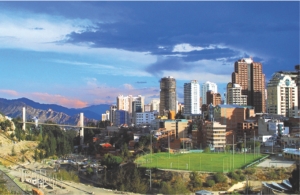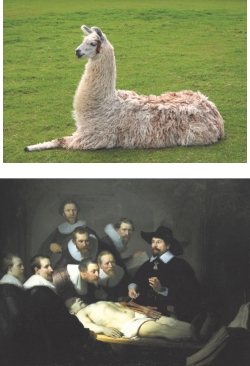| Home - Back Issues - The Team - Contact Us |
 |
| Volume 11 |Issue 30| July 27, 2012 | |
|
|
Travel ANATOMY Andrew Eagle
There's nothing better than a good prop to garnish a presentation. In an English assessment for example, a visual aid can divert attention from grammar imperfections, stumbling vocabulary and a lack of planning beforehand. Fernando knows this. That's why, when I asked him to give his presentation to the class, he promptly unzipped his backpack and pulled out a genuine, bona fide human skull. It's not that the unexpected is exactly out of place in the Bolivian capital of Nuestra Señora de La Paz. With regularity the streets are blocked by marching bands and dancers twirling and weaving their way in syncopation for several kilometres at a time, for festivals and in rehearsals for festivals. With regularity the streets are blocked by protests, by villagers airing their grievances or students chanting slogans with banners unfurled to be met with tear gas and water cannons. And when the miners come they've been known to light sticks of dynamite and call out a warning to stand clear before hurling it to a spot where no one is likely to be injured. Indeed La Paz is a city where the bulk of the mountains to the east cut from the sky a jagged horizon, and the shadow of crevice, crevasse and cliff provide a foreboding backdrop as the denizens go about their days. Neither was the unexpected exactly out of place at the language institute. It was housed in a former mansion and there were rumours that a ghost used to wander between the upstairs classrooms. Some of the Spanish teachers claimed to have encountered it. There were odd stories of various happenings like the day Sergio mentioned that he'd been unable to attend the previous class due to his uncle's funeral. His family had been very upset, he said, until his uncle came back to life! He was asked to clarify. As the coffin was being lowered into the grave, Sergio said, the family had heard a strange knocking sound from inside. The coffin was opened and it was discovered his uncle had not, in fact, died. Sergio's family was overjoyed after that, he said. 'Okay, well try not to miss class again…' And on the second of August when fires burn across the city the language institute is no exception. It's an auspicious day on the Aymaran calendar when businesses seek the patronage of the benevolent Pachamama, the mother-spirit of the world by performing the challa ritual. At the institute a traditional priest, a yatiri, was called to perform the ancient ritual that would bring blessings to the business for the coming year. Yatiri means 'someone who knows,' what distinguishes them from others in the community, and by tradition they have been struck by lightning, which is understood as a calling to undergo the initiation as a yatiri; indeed it is believed that with the lightning strike the person has died and passed through death onto rebirth.
He was an old man, small and wrinkled, sporting a dusty jacket and a felt hat; and he set about laying newspaper on the floor of the reception area, followed by butcher paper, as a bird starts to build its nest. From black polythene bags he produced various other items, white llama wool, multicoloured cotton wool and sacred coca leaves. To the spectators he offered a few coca leaves to chew, a custom not dissimilar to betel chewing in Bangladesh, before busying himself adding a variety of what look like large lollies or mothballs: round ones, flat ones, brightly striped and pink ones, to his arrangement on the floor. He called each of the spectators in turn, placing in their hands a few of these ornaments to add to the offerings, before reciting prayers to the mountain spirits, to the water and the sky. Some shreds of llama fat were added before further prayers and then lastly, from another black polythene bag he brought forth the hard, black, dried llama foetus which he subsequently started to wrap in more cotton wool. 'He's dressing it,' the institute director told me. The foetus symbolises life-force. A fire was stoked in the room's hearth, for the reception area was once a drawing room, and the yatiri poured local alcohol called chicha into a glass. In accordance with Aymara ritual he walked around the room tipping a little onto the floor in each corner in tribute, before throwing the rest onto the fire. Each of the spectators repeats the custom in turn. He then does the same once again only substituting alcohol for kerosene, interrupted only by a call on his mobile. Lastly the offering he's constructed on the floor is placed above each person's head, with a blessing said, before being transferred to the fire. The ashes will be buried on the following day in the garden, the year's blessing completed.
Such ceremonies are common across Bolivia, on the second of August and at other times, including at government occasions and functions. In new buildings in La Paz, a sacrifice to Pachamama is a pre-requisite, with a llama foetus buried in the foundations. For larger premises an adult llama is sometimes used to infuse life force, and there were other, more disturbing rumours… 'I will talk about anatomy,' Fernando said of his presentation, and as one of his medical specialisations it was a subject close to him. He used to lecture in anatomy at the university as well as working in a hospital. It's the reason he had access to bones. For the next ten minutes he pointed from eye-socket to jaw bone, successfully diverting attention from confusion between the present simple and simple past. The nose cavity disguised various pronunciation foibles and the hole for the spinal column captivated as he searched for the English version of the Spanish skull-related vocabulary that he knew so well. It was a female skull he explained. There were questions. 'What was the possible cause of death?' asked Karen. 'When you are working with dead bodies in the lab, did you ever see one move?' asked Bernarda. 'Don't you feel a bit horrible working with dead bodies?' asked Katherine. Then it was Marcio's turn. He was the seventeen year old whose life ambition at the time was to become wealthy before retiring to a cave to live as a hermit, so he once said. His question: 'Can you get me one of those to use as a lamp in my bedroom?' From there the conversation turned to body-snatching and the possibility that skeletons might indeed be available at the city's cemeteries. 'You get used to dealing with dead bodies,' Fernando explained, 'We need them for training. I always have a few bones in my backpack.' Fernando: there's no doubt he's an accomplished medical practitioner, but he's not great at completing his English homework, just quietly.
|
||||||||
Copyright
(R) thedailystar.net 2012 |
 P
P
